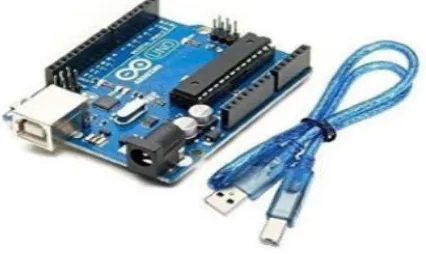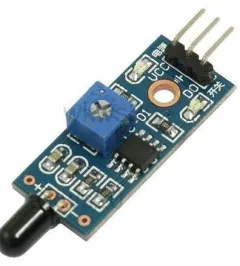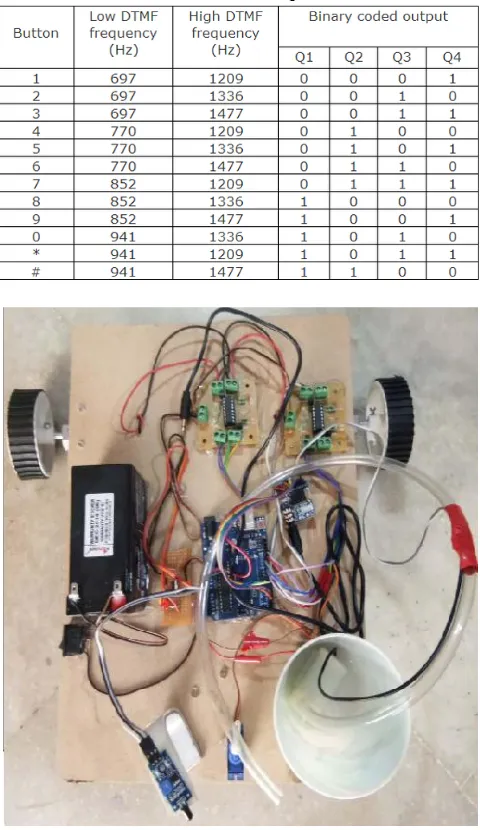International Journal of Innovative Technology and Exploring Engineering (IJITEE) ISSN: 2278-3075, Volume-9 Issue-1, November 2019
Development of DTMF Centred Remotely Located
Fire Extinguishing Robot
P. Surya Chandra, V. Revathi, A. Sireesha, N. Suresh Kumar
Abstract: The hazardous situation such as conflagration makes the humans’ life most inconvenient and risky. It is an unavoidable situation and it is very difficult for humans to face such situations. But mechanical devices can handle such situations without Human intervention. Sometimes it is also difficult to reach fire place at remote location. A robot can easily handle such situations and can efficiently work in hazardous units. The robot can easily reach the places where man cannot reach. In the present paper a fire extinguisher robot is developed to detect fire and the robot smidgens water on flames. The robot is operated and controlled with mobile phone. Dual Tone Multi Frequency tones are produced to control the movement of the robot. In the present work an Arduino UNO microcontroller is interfaced with fire sensors and generates sequence of steps to control robot movements, direction, and pumping of water. The robot movement and other operations are controlled from remote location.
Keywords: Arduino, fire extinguisher, flame sensor, IoT, DTMF
I. INTRODUCTION
In the present work an electro-mechanical device is used to meet the current objective. When the electro-mechanical device is automatically control its functionalities by artificial intelligence and easily reprogrammable then the device is called as robot. In the present work a robot is developed which can automatically detect any ignition or flames and take decision whether to sprinkle or not to sprinkle water or any material to off the flames. The robot need artificial intelligence to control and manage its functionalities assigned to it. The artificial intelligence is incorporated through programming which is saved in Arduino UNO microcontroller and treats as platform to produce various commands. These Arduino commands are used to control the movement, direction of the robot and takes appropriate action in response to the fire sensors[1].
In the conventional electro-mechanical robotic system there was no automatic-control on its movements or no management on decision making. This may lead to fail in critical fire caught situation. In the present system an internet based mobile controlled fire-extinguisher is developed to spray fire-controlled- material. A mobile app is used to communicate with the remotely located robotic vehicle. The mobile app efficiently controlled the movements of the vehicle which is remotely located at hazardous place.
Revised Manuscript Received on November 05, 2019
P.Surya Chandra, GITAM Institute of Technology, GITAM (Deemed to be University), Visakhapatnam, India
V. Revathi, GITAM Institute of Technology, GITAM (Deemed to be University), Hyderabad, India
A. Sireesha, GITAM Institute of Technology, GITAM (Deemed to be University), Visakhapatnam, India
N. Suresh Kumar, GITAM Institute of Technology, GITAM (Deemed to be University), Visakhapatnam, India
At the same time mobile app gathers required information from hazardous point [2]. The traditional fire control systems have demerit that they operate with limited frequency and has limited work range. When compared with traditional system the new and advanced system has overcome with the existing limitations such as it can work at large work range, enhanced control system. The new system can work and operated in large working area as large as the service provider has the network. In traditional systems RF communication is used to control robot where there is limitation with communication range [3][4]. This can be overcome with DTMF tone.
In the present two mobile phones are attached at two places, one is at user and the second one is attached with the robot working at hazardous unit. One of the mobile works as transmitter and the other one works as listener. The transmitter calls the other mobile with corresponding mobile number and the listener listens or responds the transmitter call. During this call process the user can activates robotic modules with corresponding key pressings through transmitter mobile. The user can control the robotic modules by sending key commands to the receiver. After pressing the key at transmitter mobile the corresponding key tone will be listened at receiver end. Upon receiving key tone from transmitter the listener triggers various modules of recever at elctromechanical robot such as forward(), backward(), stop(), spray(), and other. The transaction of tone is termed as “Dual Tone Multiple-Frequency (DTMF)” tone.
Accordingly, in the present work a DTMF tone based robot is adopted to make flexible control over long range space. The DTMF based robot is selected because the robot can be communicated easily with mobile phone from remote location and can also monitor the status of the robot surrounding environment. To understand the mobile DTMF tone the robot need an extra hardware called decoder. The decoder will help the robot to understand the DTMF tones send by the user. In the present work the DTMF tones are tracked and retrieved with help of a mobile phone piled along with the robot. The received tones are decoded and processed with the help of DTMF decoder and an Arduino microcontroller respectively.
The decoder converts the DTMF tone into corresponding binary bits to make it compatible with Arduino microcontroller. The microcontroller produce respective control signals after receiving binary bits from DTMS decoder. Based on the binary input to the microcontroller, the microcontroller outputs control signals to respective motors for controlling the robot direction and sprinkling foam or water. Appropriate control signals are generated with pre-programed microcontroller [3][5].
II. CIRCUIT DESIGN
The block diagram of DTMF based fire Extinguishing Robot is shown in figure 1.
of various functional units which plays key role in detecting fire at surrounding‟s and extinguish the fire with proper commands. The block diagram has key elements like flame sensor, Arduino UNO microcontroller, DTMF, motor driver, and water pump. The primary objective of the current system is to detect the fire location and extinguish the fire by sprinkling the water with the help of the pump with DTMF technology. Here, the flame sensor is used to sense the fire and sends its output to microcontroller. The two frequencies of DTMS is fed to microcontroller to set/enable the operations in the overall system. A water pump is interfaced and controlled with the microcontroller in ordered to pump the water on fire places. The motor driver is controlled by microcontroller in ordered to control the simple DC motor. The DC motor converts electrical signal/energy to mechanical energy. The DC motor will drive the electro-mechanical robot forward and backward [6][7].
[image:2.595.51.292.268.401.2]
Figure 1 Functional Block Diagram of DTMF based fire extinguisher
2.1 Arduino UNO
In the present work an Arduino UNO microcontroller shown in figure 2 is used to meet the target functionalities. The Arduino is embedded with pre-programmed to control the robot operations and to monitor real time functionalities like fire sensing, triggering pump, and controlling the speed of wheels through motors. The Arduino supports total 14 digital Input/output multi-functional pins. These pins are captivated to 6 PWM output pins, 16MHz quartz crystal, similarly it supports 6 analog input pins. Apart from input and output pins it also has power pin, reset pin, a USB connector, and ICSP header pinout. The board is supplied with 5V power supply.
Figure 2 Arduino UNO microcontroller board
A range of 5-12V power supply [7] is connected to avoid instability in device functionality. A voltage level of 12V and more than that may damage the microcontroller kit. Hence it is always preferred to work at safest medium range. The pin ICSP stands for „In Circuit Serial Programming‟ generally used to restore bootloader. All ICSP pins are also used for interfacing with similar pin found in another Arduino board. Initially the program is compiled on Arduino IDE on computer and uploaded into Arduino board after successful compilation.
2.2 Dual Tone Multi-Frequency (DTMF)
[image:2.595.325.527.472.662.2]The main objective of the DTMF decoder is to interface the decoded binary bits with the Arduino or any computer. The Dual Tone Multi-Frequency is used in establishing communication between telephone sets or other communication devices by means of voice frequency band. The DTMF represents different forms of information such as symbols, letters, and numbers with transmission of pairs formed by the combination of different frequency signals. For instance, when a key is pressed on mobile handset corresponding DTMF tone will be generated. Every DTMF tone comprises of two different frequency components. The resultant tone is an intricacy of two frequencies one is higher frequency range (>1khZ) and the second one is lower frequency range (<1khZ). The two frequency components are decoded into respective binary code formats. The DTMF decoder decodes the dial tones received from the keyboard on the mobile phone. The decoding is implemented in the present work with a decoder IC MT8870DE shown in figure 3.
Figure 3 DTMF Decoder 2.3 Motor Driver
The motor driver is used in the present design to control the motors interfaced with the wheels. The motor driver is an interface device between motor and microcontroller. The L293D is a motor driver used to convert low current signal into high current signal.
[image:2.595.54.267.633.760.2]International Journal of Innovative Technology and Exploring Engineering (IJITEE) ISSN: 2278-3075, Volume-9 Issue-1, November 2019
current amplifier to enable and control two motor. The motors are initially enabled with Arduino pins 1 and 9. An active high signal will enable the respective motor otherwise disables the motor. The Arduino pins 2, 7 and 10, 15 are interconnected with motor driver through which the motor operations are controlled. The binary bits 00 and 01 are used to stop the respective motor, and binary bits 01 and 10 are used to control the motor direction either in clock wise or anti-clock wise direction respectively.
2.4 Flame Sensor
[image:3.595.97.217.431.564.2]The main objective of the flame sensor is to detect the presence of fire and produce corresponding electrical signals. There are other sensors smoke detector and heat detector involved in detecting fire. But, the fire detector produces the results with accurate readings. The flame sensor is physically light weighted, small in size, easily carried and mountable. The flame sensor shown in figure 4 senses the fire based on the presence of fire or presence of other light sources or infrared sources. The flame sensor is used in many industrial applications like blast furnace, Gas-fueled cookers, and industrial ovens, hydrogen furnaces, drying systems, power plants, turbines and fire-fighting robot [8][9]. A small length of metallic shaped fire sensor is immersed in the target place to detect the presence of fire. The sensor data pin is connected to one of the General Purpose Input Output pin of Arduino microcontroller. Each DTMF tone is further converted into 4-bit nibble.
Figure 4 Flame Sensor
III. IMPLEMENTATIONS
The mechanical robot along with Arduino microcontroller and the sensor is located at the hazardous unit. The mobile phone through which DTMF tones are generated is located at user end. From remote locations the user can operate the robot by converting DTMF frequencies into corresponding commanding functionalities at robot. When a key is pressed on the mobile handset the corresponding frequencies belonging to the rows and columns will be generated. The row frequency come under lower frequency and column frequency comes under high frequency group. A sinusoidal tone will be generated when a key is pressed on the key
board. The corresponding row and column frequencies will get selected as shown in figure 5.
Here each key has particular tone frequency at row and column and generates a mixing frequency when a key is pressed. For example when a key 8 is pressed it produces a toned frequency 1336+852=2188 Hz.The DTMF is an 18-pin IC package which integrates both band split and decoder functions. The decoder converts DTMF tone pairs into corresponding binary code using digital count techniques. The guard time and gain control of the input signal is controlled through external RC circuits. The guard time depicts that, it is a time required to detect a valid DTMF tone. The successful recognition of DTMF tone is tested with Q-test signal of DTMF decoder. On the other hand a flame sensor at the Arduino is used to detect flame and variations in infrared light. Comparatively flame sensor produce accurate results than other sensors. The output pin of flame sensor produces an +5V or high signal when there is no sense of fire. The output pin goes to zero when it detects a fire. The flame sensor works based on working principle that, it emits an infrared light when it detects fire. The photo diode will detect that infrared light and produce small amount of voltage, which is further amplified to make it compatible with standard microcontroller. The photo diode of flame sensor can detect infrared rays of wavelength in the range of 760nm to 1100nm. The sensor output pin is connected to one of the input (GPIO) pin of microcontroller as shown in figure 6 [7][10].
Figure 5 DTMF frequencies
In the present design the robot movement is controlled with the help of two wheels and they are controlled with two DC motors. The two motors are controlled with a motor driver with IC name L293D. The motor driver will act as mediator between microcontroller and four DC motors. Base on the DTMF tones the Arduino receives the binary signals from DTMF decoder. According to these binary signals the microcontroller send control signals to motor through motor driver. The motor driver
[image:3.595.315.541.435.621.2]microcontroller and sends compatible voltage signals to motors. In response to the Arduino microcontroller the motor driver produces necessary high current signals and high voltage to the respective DC motor. The DC motor receives the electrical signal from driver and converts electrical signal into mechanical energy. This mechanical energy is used to produce momentum in wheels to carry the robot to the hazardous unit. The 2nd and 7th pins of L293D are used to enable the motors connected to the left wheels and 10th, 15
th
[image:4.595.307.547.124.539.2]pins are used to produce rotation on right hand side motors connected to robot as shown in figure 6. The motor shaft rotation angle and speed is controlled by sending appropriate signal to motor driver inputs. The angle and speed of the motor is measured with the help of a potentiometer connected at the output shaft. The angle of rotation of motor can be varied by setting different widths for pulse width modulation input at Arduino pin. The prototype of the design is shown in figure 7.
Figure 6 Circuit Diagram
IV. RESULTS
The Robotic wheels are controlled and angle of rotation is accurately managed from remote location. The mobile keys are represented with DTMF tones and they are recognised with DTMF decoder. The corresponding DTMF tone frequencies are shown in table 1. The decoder output is fed to microcontroller to enable motors, to set shaft angles and to manage the shaft speed. The pre-programmed Arduino microcontroller sprays water on fire based on the sensor output.
V. CONCLUSIONS
A prototype of robotic fire extinguisher is successfully developed in the current work. It worked more accurately in detecting fire.and sprinkling the water. The shaft angles are correctly measured and accordingly the wheels are moved in correct direction. The robot Direction is managed according to the DTMF tones. The DTMF tones are decoded and feed to Arduino to produce respective commands to control the
direction. The existing RF communication limitations are overcome in the present DTMF centric model. The robot can be controlled through large area which is almost equal to the mobile signal area.
Table 1: DTMF frequencies
Figure 7 Robotic Fire Extinguisher circuit
REFERENCES
1. Kristi Kosasis e al., “The Intelligent Fire Fighting Tank Robot”, Electrical Engineering Journal Vol.No. 1, pp. 73-80, 2010.
2. V. Mangayarkarasi, “Remote Controlled Fire Fighting Robot”, International Journal of Trend in Scientific Research and Development, Vol 2, No 5, 2018, pp 820.
3. N. Suresh Kumar et. al. / International Journal of Engineering Science and Technology., “Virtual Software to Design and Interface peripherals with different Microprocessors” Vol. 2(5), 2010, 1143-1146.
4. Samantha Cardoso et al., “Literature Survey on Fire Fighter Robot”, International Journal for Scientific Research & Development, Vol. 5, Issue 01, 2017
5. N. Suresh Kumar et al., “Multi-dimensional parametric assessment with IoT in acquaintance of digital pipeline”, International Journal of Electrical and Computer Engineering (IJECE), Vol. 9, No. 6, December 2019, pp. 4649~4656.
[image:4.595.53.287.299.482.2]International Journal of Innovative Technology and Exploring Engineering (IJITEE) ISSN: 2278-3075, Volume-9 Issue-1, November 2019
Research Journal of Engineering and Technology, Volume: 06 Issue: 04, Apr 2019
7. Kuchi N S S S S Utpala et al., “Authenticated IoT Based Online Smart Parking System with Cloud”, Pramana Research Journal, Vol 9 no 4, 2019
8. B.Swetha Sampath, “Automatic fire extinguisher robot”, 8th international conference on ubiquitous robots and ambient intelligent, nov 23-26, 2011 songdo conventia, Incheon, Korea
9. N. Suresh Kumar et al., “Digital frequency meter using DMA Terminal Count Stop method”, International Journal of Engineering and Technology (IJET), vol2 (2), 2010, 34-37.
10. Tushar Nandkishor Satbhai et al., “Fire Fighting Robot”, International Journal on Recent and Innovation Trends in Computing and Communication,Volume: 4 Issue: 4.
AUTHOR PROFILE
P. Surya Chandra has more than 11 years of teaching experience and has handled several subjects for CSE&IT students. During his experience he has published numerous research papers in various International journals and conferences.
vankayalapati Revathi has more than four years of teaching experience and has handled several subjects for IT students. During her experience she has published numerous research papers in various International journals and conferences.
Sireesha A has more than five years of teaching experience and has handled several subjects for Computer science engineering students.
Dr. N. Suresh Kumar research of interest is parallel
processing, Natural Language Processing,
Reconfigurable Computing Systems, Information Communication Technology, IoT, and Computerized Process Control Measurement. He is currently working as Assistant professor in GITAM University, Visakhapatnam, India. During his 16


